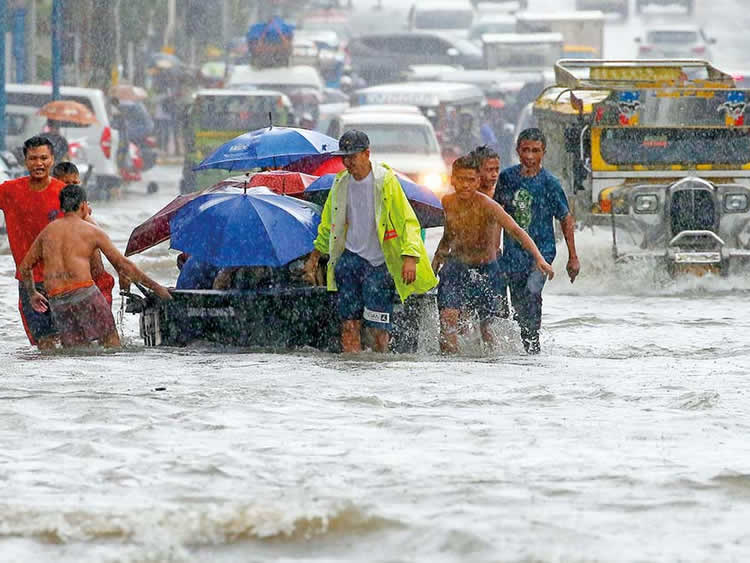 Flooding in Metro Manila streets. Photo: Associated Press
Flooding in Metro Manila streets. Photo: Associated Press
 recent editorial of the Philippine Daily Inquirer titled, Metro Manila on Borrowed Time, points to the fact that some scientists predict that in a worst-case scenario, sea levels could rise by as much as 2 meters by 2100. Such sea-level rise “will be devastating for archipelagos like the Philippines, where 62 percent of the population live in coastal zones.” recent editorial of the Philippine Daily Inquirer titled, Metro Manila on Borrowed Time, points to the fact that some scientists predict that in a worst-case scenario, sea levels could rise by as much as 2 meters by 2100. Such sea-level rise “will be devastating for archipelagos like the Philippines, where 62 percent of the population live in coastal zones.”
The Inquirer editorial, based on the recently published Proceedings of the National Academy of Sciences, a preeminent journal published by the Washington, DC-based organization, noted that “in the Philippines, 65 million of the 105 million estimated population live in coastal communities, putting them on the front lines of disaster.”
To make matters worse, the editorial points out that “Metro Manila, the country’s dense sprawling center of government and business,” is also sinking likely due to groundwater pumping.
The Inquirer notes that an October 2018 study of eight cities (Jakarta, Bangkok, Lagos, Manila, Dhaka, Shanghai, London and Houston) titled “Sinking Cities, Rising Seas - A perfect storm of climate change and bad development choices” published by Christian Aid, a UK-based charity, painted a dire future for Manila, one of the eight cities in the study.
It warns Filipinos that “groundwater extraction contributing to subsidence is also relevant to the Philippine capital, Manila and its 12.9 million people. Ground water use is causing sinking of around 10 cm per year, or ten times the rate of sea level rise through melting land ice and thermal expansion. Since the city has an average elevation of around 5m, it seems to be living on borrowed time. The subsidence not only increases the absolute risk of flood, but also the areas affected: high tides can penetrate further inland and floods may recede more slowly. This means that there is increased risk of salination of soils that were previously fertile.”
The Inquirer editorial goes on to point out that “Metro Manila is already groaning under the weight of its 13 million population and has witnessed unchecked urbanization over the decades—developments that have only compounded the effects of global warming.”
“Neighboring countries are in the same boat. Indonesia, the world’s largest archipelago, recently announced plans to build a new capital city because Jakarta, its current capital, is sinking. ABBC report as tagged Jakarta as the fastest-sinking city in the world. With almost half of its area now below sea level. Experts say that by 2050, 95 percent of North Jakarta will be submerged,” notes the editorial.
But it also laments that “these environmental issues merited scant to zero mention by the major candidates during the recent elections, despite the urgent implications … and enormous cost it would take to either save Metro Manila or, like Jakarta, relocate the capital to a safer place. Is this problem, in fact, even on the radar of the Duterte administration?”
The editorial demands that “more attention to Metro Manila’s ultimate fate needs to happen, especially on the national level” and asks “where are the studies and blueprints that should map out the government’s preparations and mitigating measures for what awaits the metropolis? Are there such studies in the first place? Or is the country’s capital destined to drown eventually—not only from natural causes, but also from the neglect and obliviousness of its inhabitants?
We thank the Philippine Daily Inquirer for bringing this urgent issue to the fore, and we look forward to the views and comments of our readers across the globe. Published 5/27/2019
|